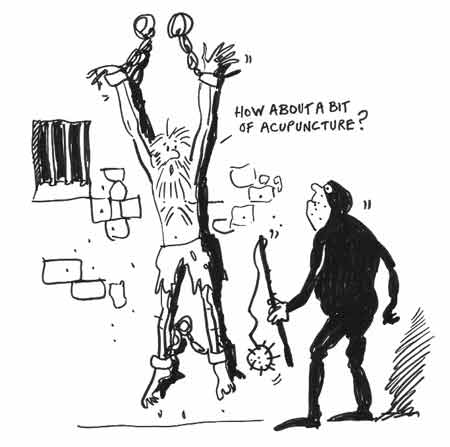|
|
|
Acupuncture helps control pain – 02/10 & 11/08 |
February 2010 Quantitative sensory testing is used clinically to help physicians understand specific injuries in nerve fibres associated with chronic pain. It includes tests of both thermal perception (heat and cold), and mechanical perception (pressure applied to the skin). The patterns of response provide diagnostic information in patients with nerve injury regarding the type of nerve involved, and possible treatments. Researchers at the University of Munich used the technique to identify changes in pain sensitivity with acupuncture in 24 healthy volunteers. They found found that pain thresholds increased by up to 50% when they applied acupuncture to one of the volunteers' legs. Effects were noted in both the needled and the un-needled leg. Two nerve fibres – the 'A delta' and the 'C' pain fibres – were specifically affected by the acupuncture and although the effects were modest, the researchers believe they justify further work with patients with chronic pain, where the effects might be more dramatic. The study used three different forms of acupuncture: manual acupuncture needling alone and with the addition of high-frequency and low-frequency electrical stimulation. All treatments were performed by an experienced acupuncturist, applied to acupuncture points commonly used in pain management. The fact that the pain relief was also felt in the leg that was not being needled suggests that acupuncture on an undamaged limb can be effective for pain relief when the damaged limb is either too painful or is not accessible – because covered with dressing for example. Anesthesia & Analgesia May 2010 November 2008 A published in the November 2008 issue of Behavioural Brain Research, utilized functional magnetic resonance imaging (fMRI) and positron emission tomography (PET) to examine the effects of acupuncture in relieving pain. The randomised study separated 12 healthy volunteers into a real acupuncture group and a placebo acupuncture group. The placebo treatment used a validated sham acupuncture needle (Streitberger placebo) so that the sensation was as close to real acupuncture as possible. During the course of four sessions, the researchers induced pain in the subjects by using heat in varying degrees of intensity. The heat pain, which was issued to the right forearm of each subject, was administered before and after a 29-min treatment of either real or placebo acupuncture at acupoint Large Intestine 4 (LI-4). The fMRI was used to indentify changes in neural activity by measuring blood flow in the brain. The [11C]diprenorphine PET scans looked for binding decreases which is associated with greater opioid release. By comparing the two treatments, the study concluded that "… the reduction in pre- and post-treatment pain ratings was significantly greater in the acupuncture group when compared to the placebo group" (Dougherty, et. al. p.3). "We found more brain changes during true acupuncture than during placebo acupuncture," commented Darin D. Dougherty, MD, Associate Professor of Psychiatry at Harvard Medical School and Director of Neurotherapeutics at Massachusetts General Hospital. "fMRI showed changes in the orbitofrontal cortex, insula, and pons during true acupuncture when compared to placebo acupuncture." The PET scans detected [11C]diprenorphine binding changes during real acupuncture that were very different than the binding changes that occurred during placebo treatment. The right orbitofrontal cortex (OFC) was the only brain region that showed a common change in both types of scans. During real acupuncture, the right OFC demonstrated increased activity (as determined by fMRI) and increased opioid release (as determined by PET). There were no common fMRI and PET changes during placebo acupuncture. The data suggests that real acupuncture affects the brain differently than placebo acupuncture and is more effective than a placebo in reducing the experience of pain.
Click here for more research reports First Published in November 2008 updated Febuary 2010 |













